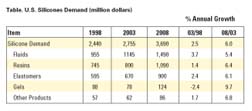
These and other trends are presented in Silicones, a new study from The Freedonia Group Inc., a Cleveland-based industrial market research firm.
Among silicone products, silicone gels are projected to achieve the strongest gains, benefiting from a recovery in electronic component shipments from a weak 2003 performance. Silicone foams and other products will also achieve above-average gains, partially arising from favorable opportunities in various transportation segments. Demand for silicone fluid, the largest category,
will be boosted by expanding applications in the cosmetic and toiletry markets. Consumer preferences for higher-end, branded products will promote greater use of silicone in formulated personal care items such as shampoo, hair styling products, sun-care lotions and skin-care lotions.

For more information, contact Corinne Gangloff, The Freedonia Group Inc., 767 Beta Drive, Cleveland, OH 44143-2326; phone (440) 684-9600; fax (440) 646-0484; e-mail pr@freedoniagroup.com; or visit http://www.freedoniagroup.com.